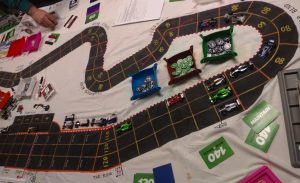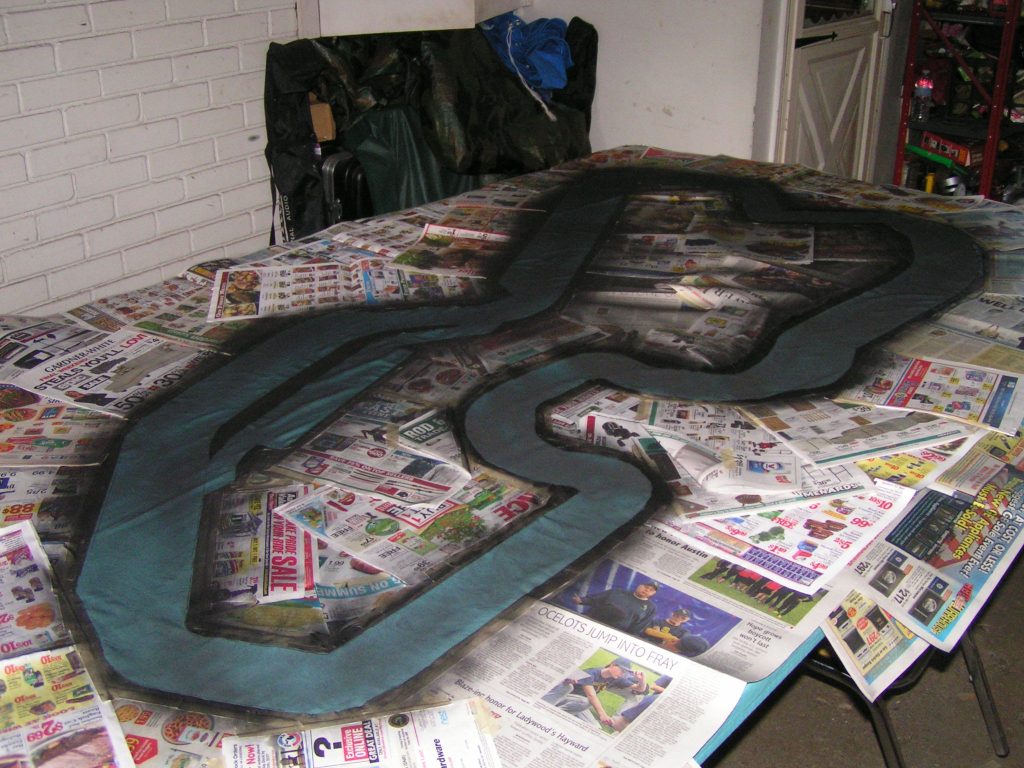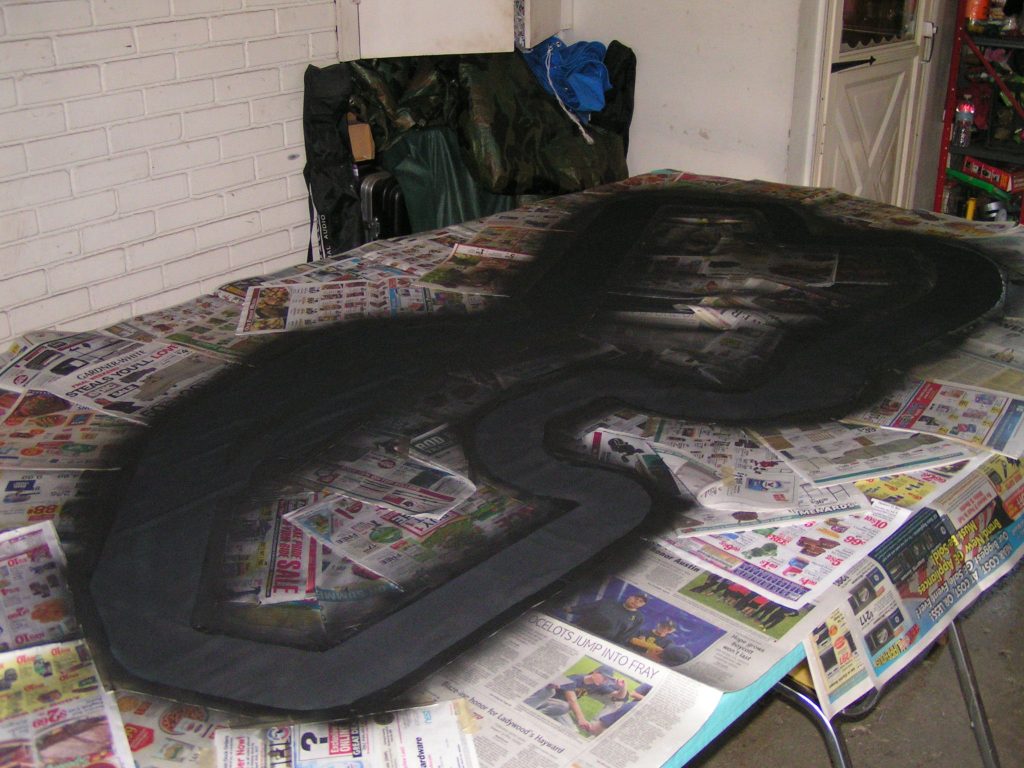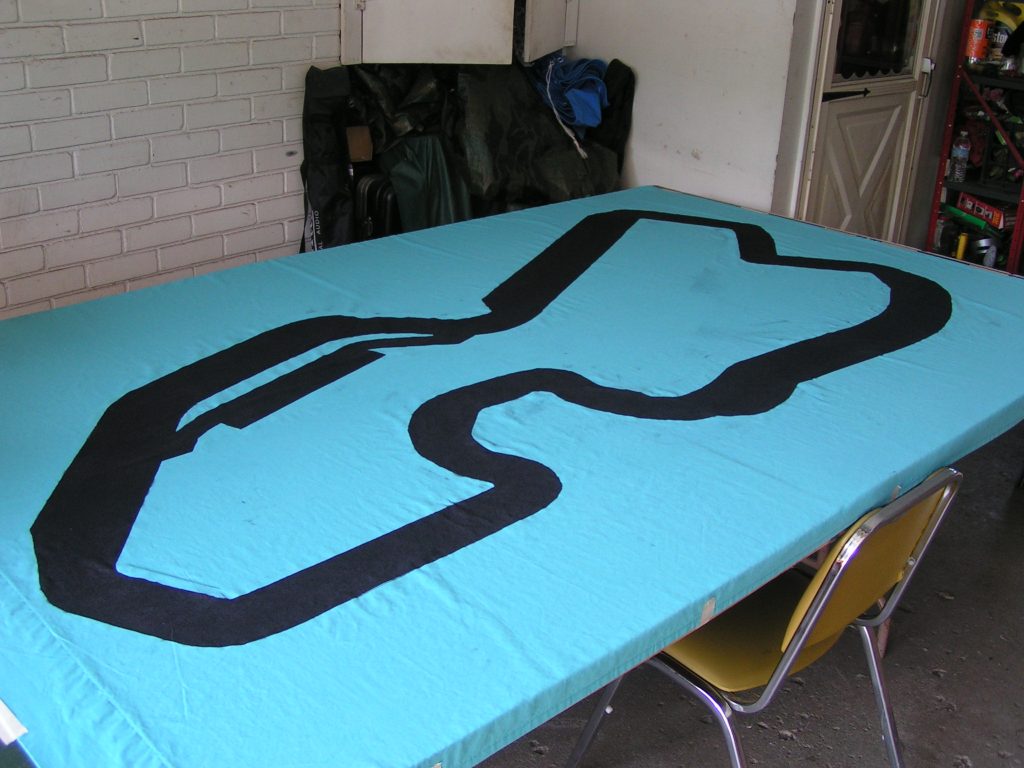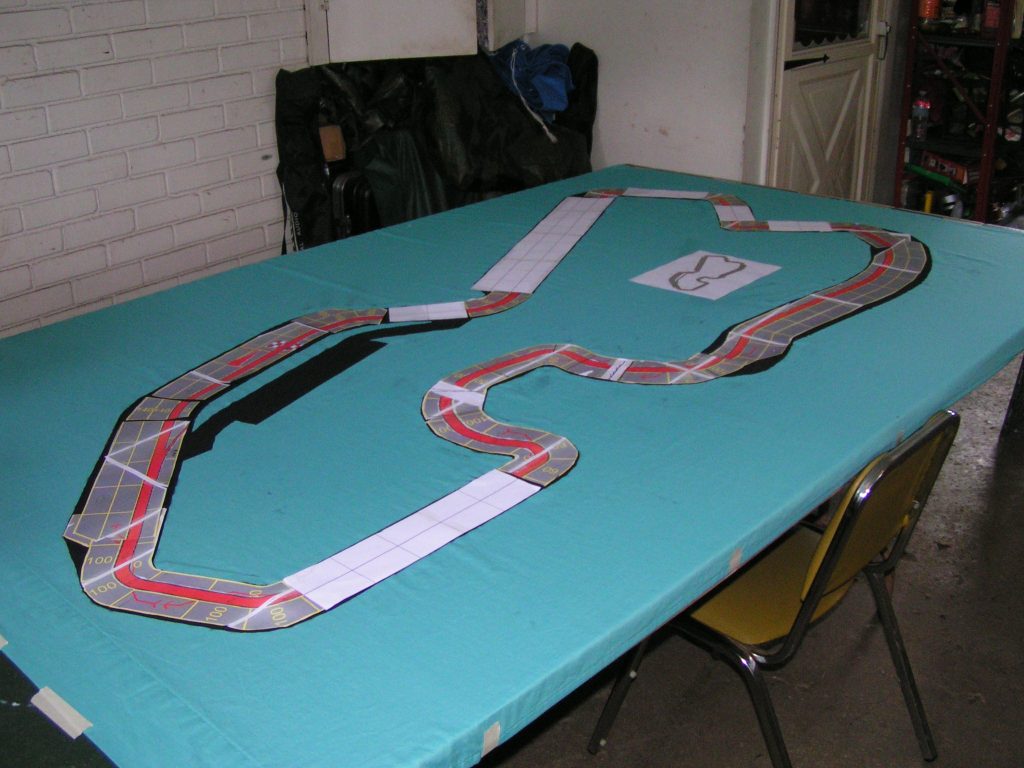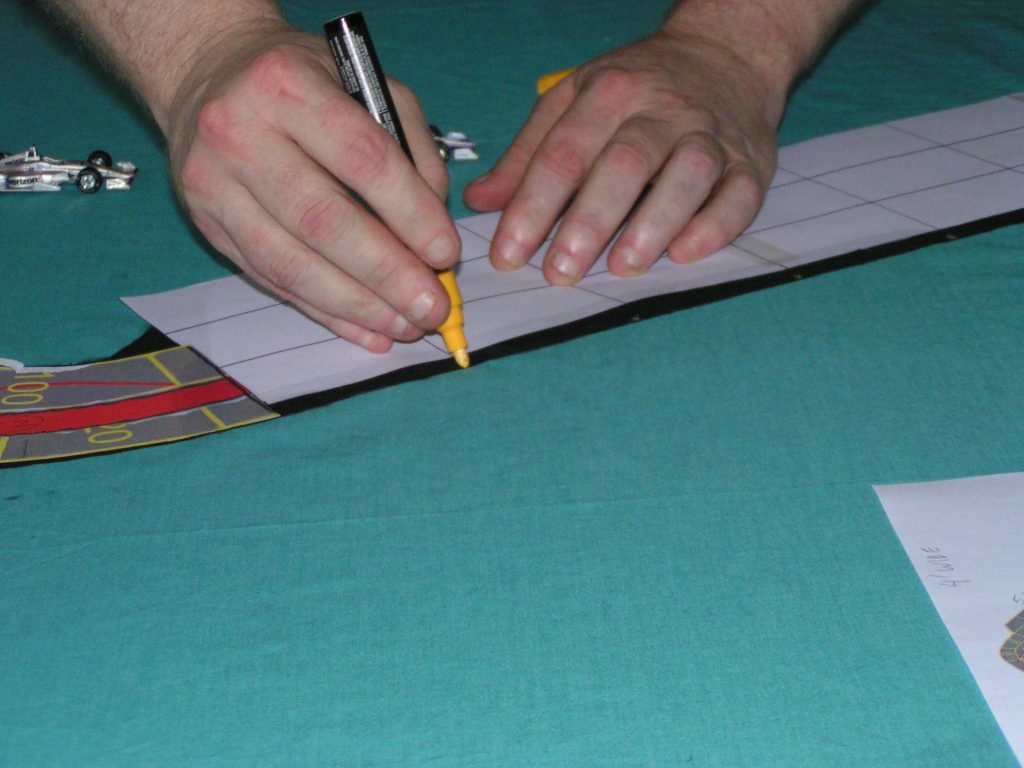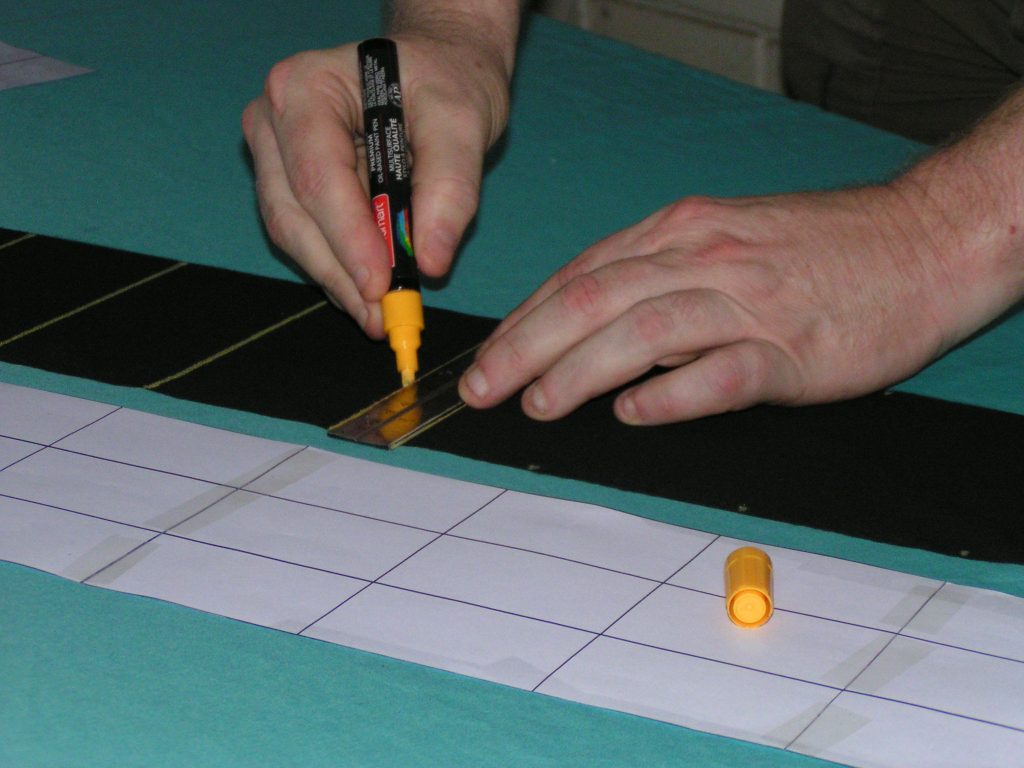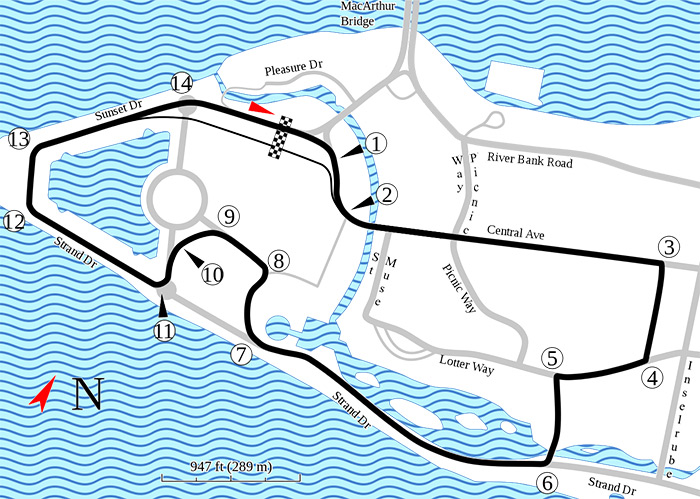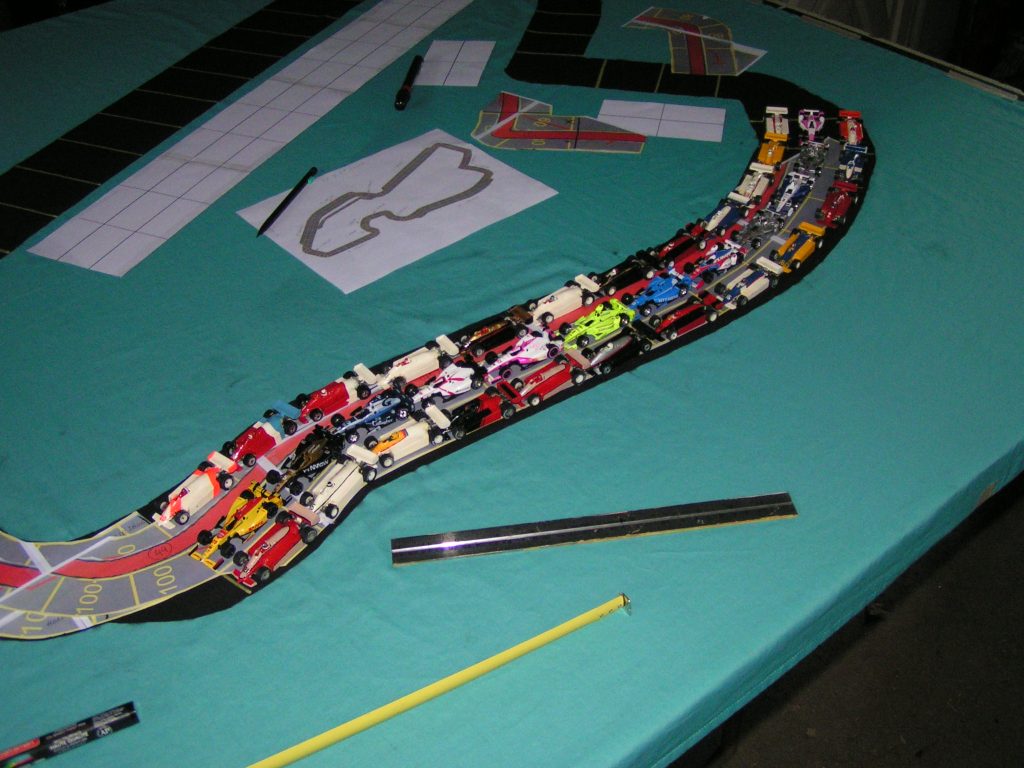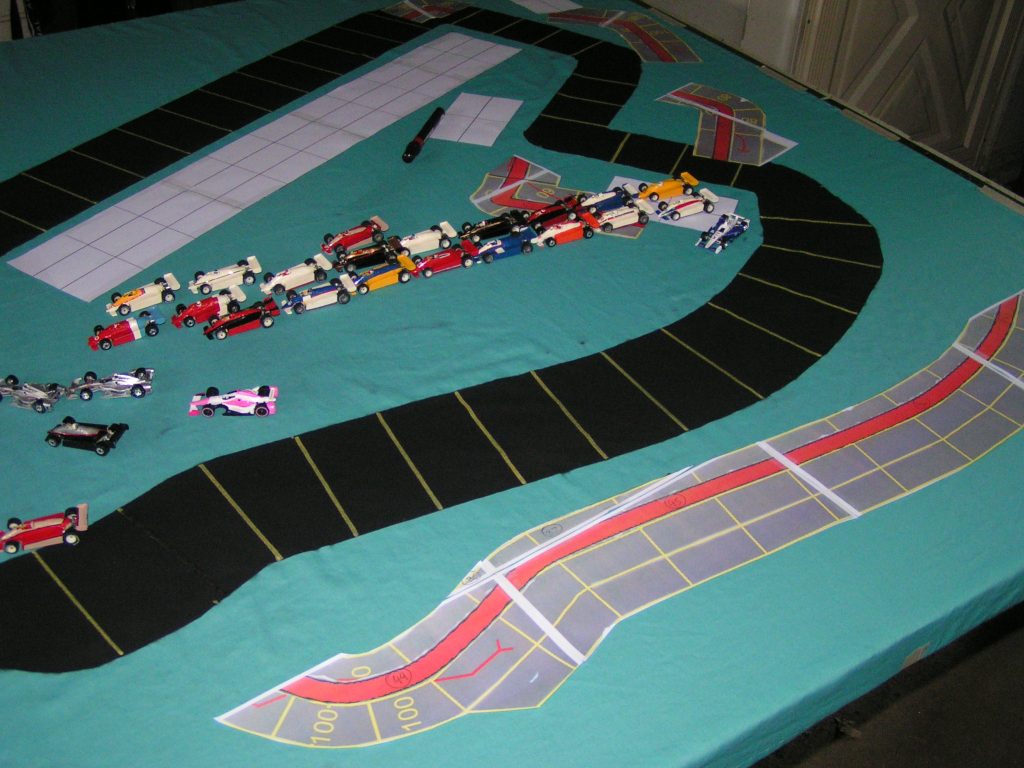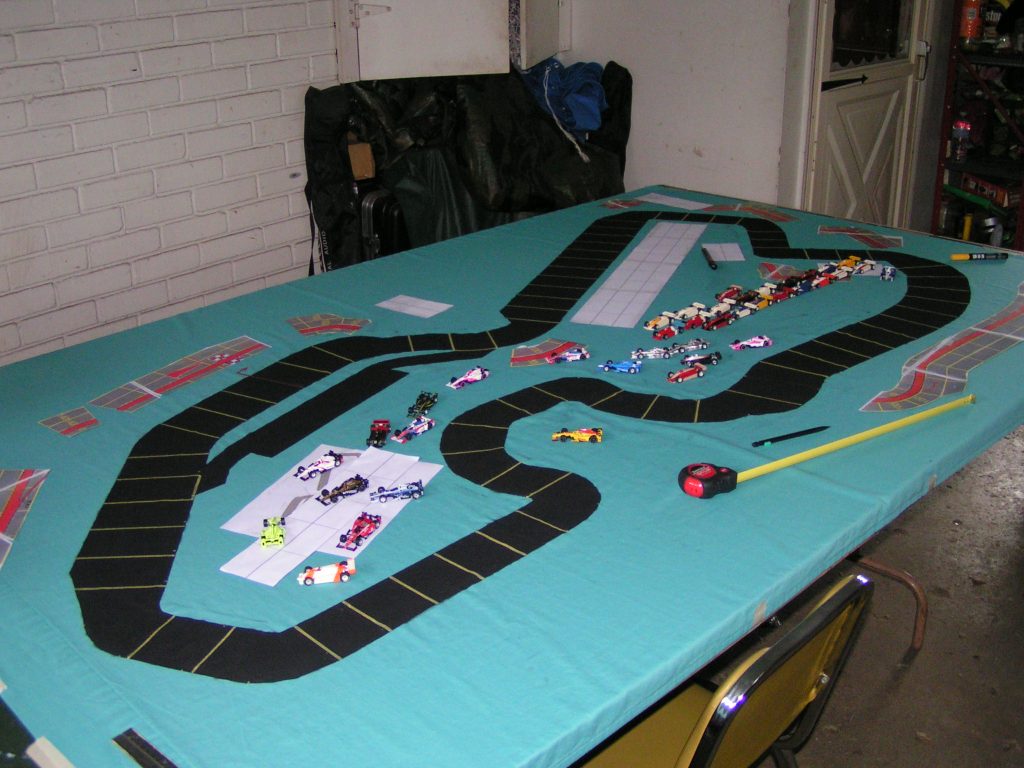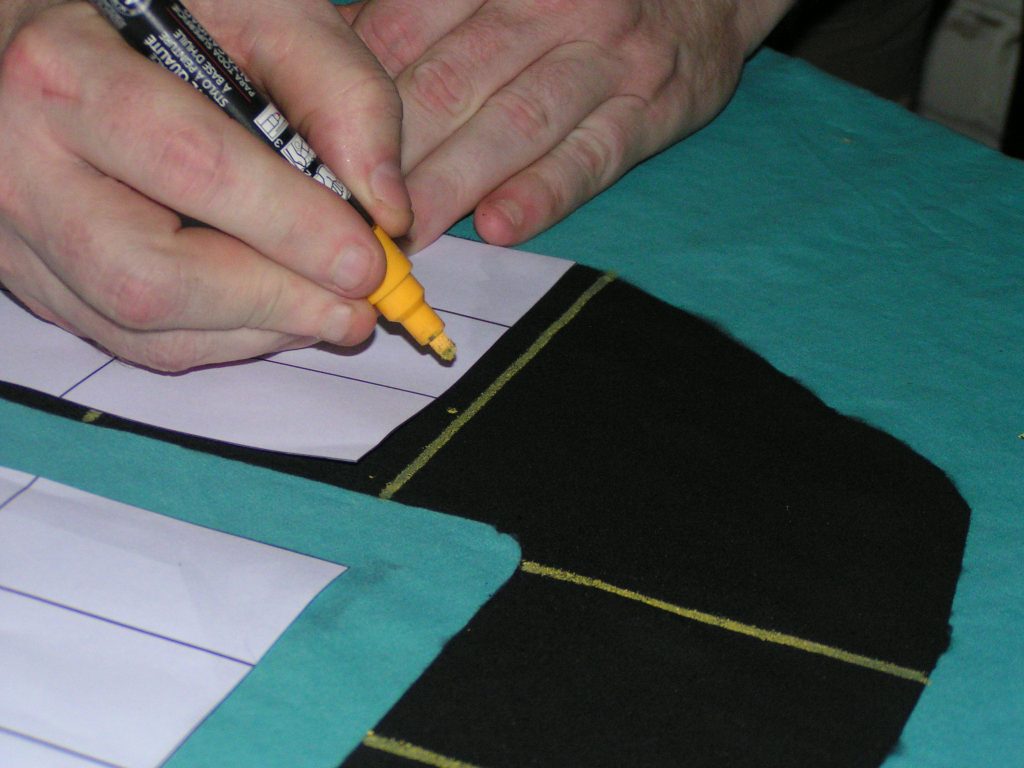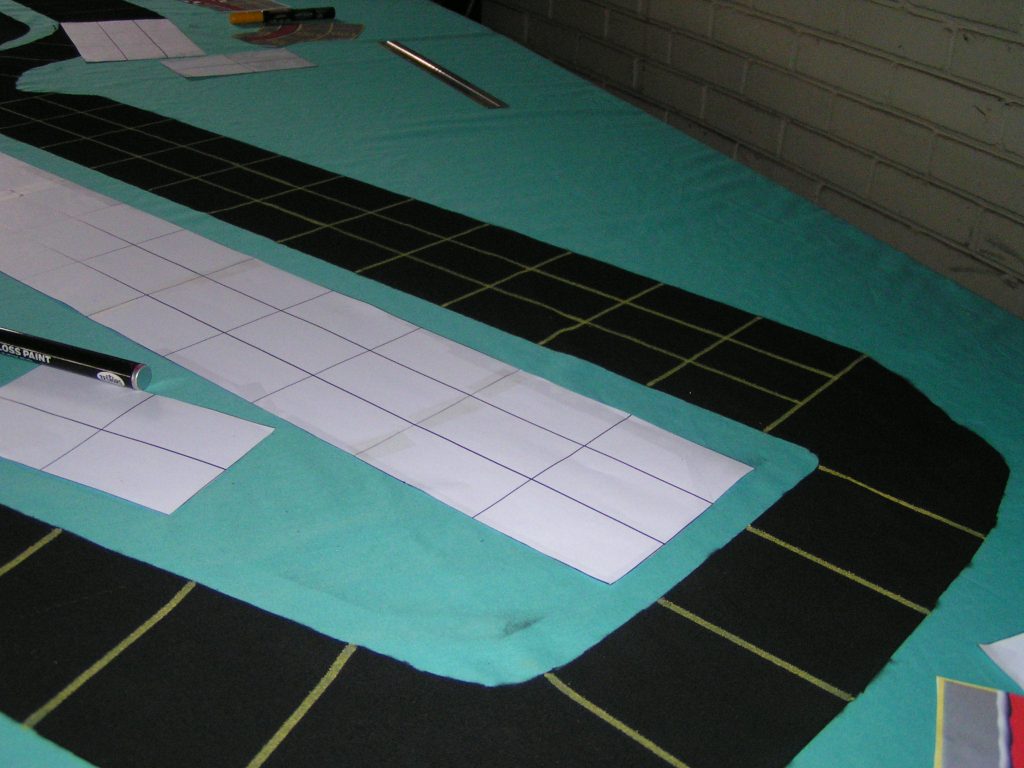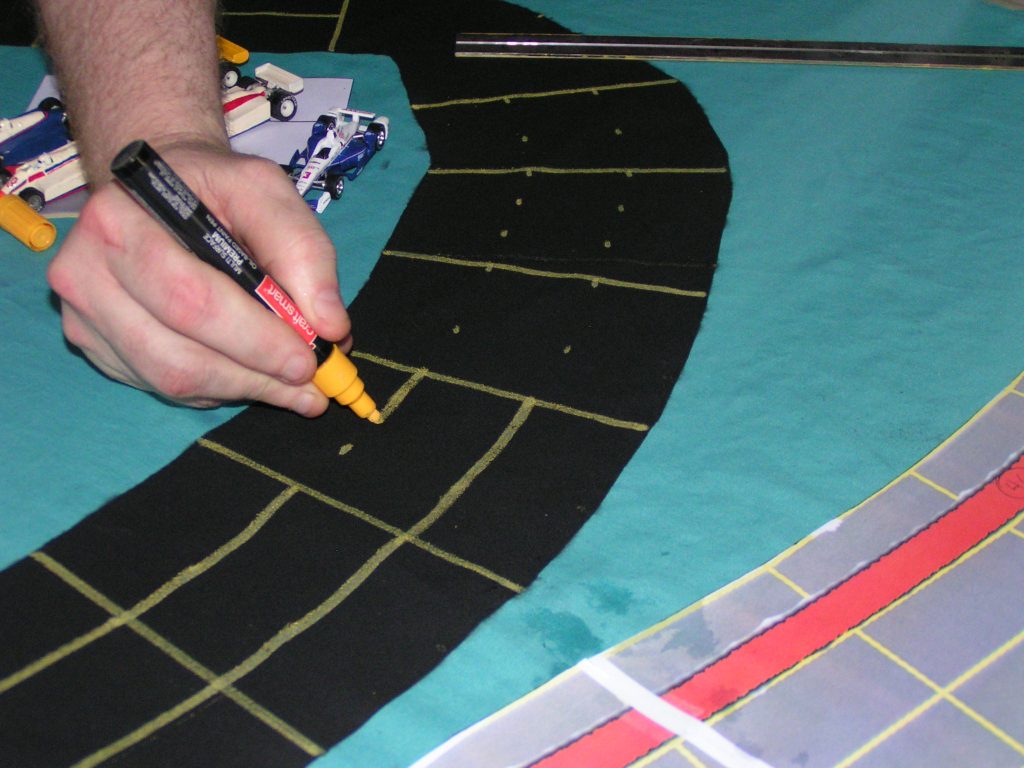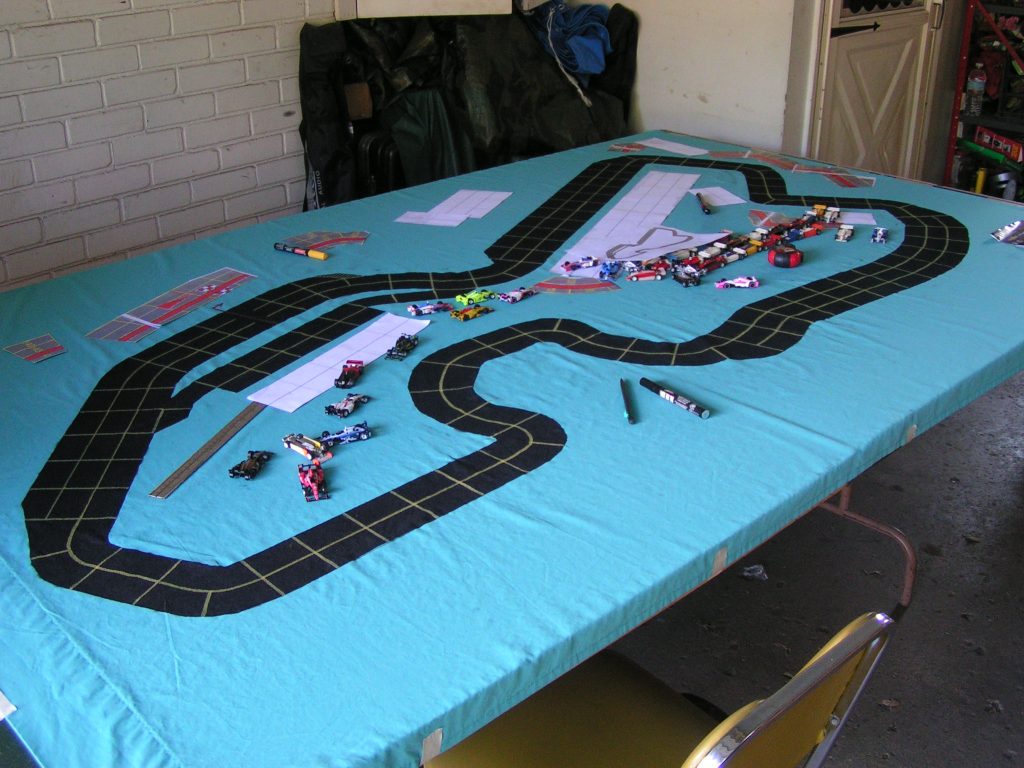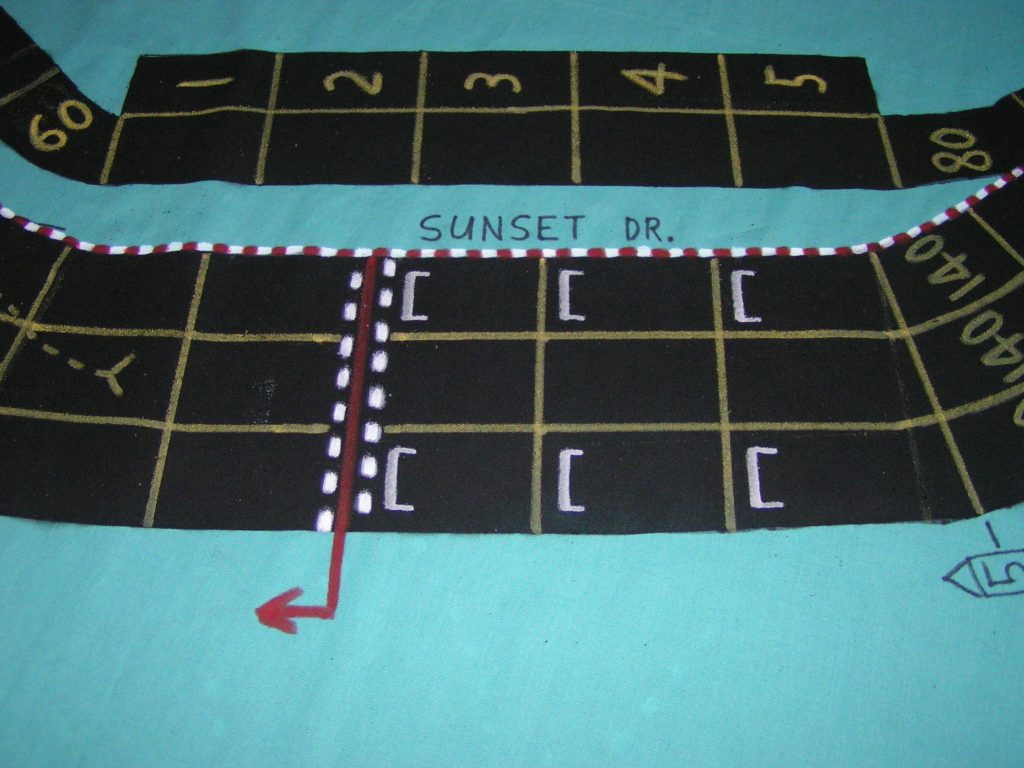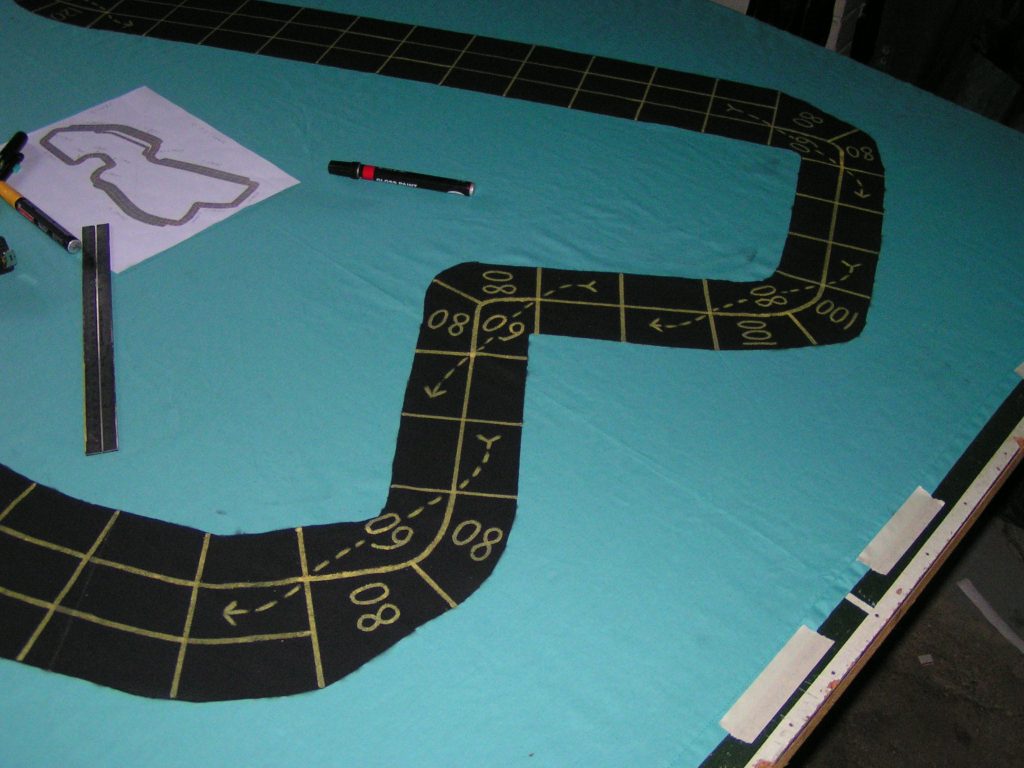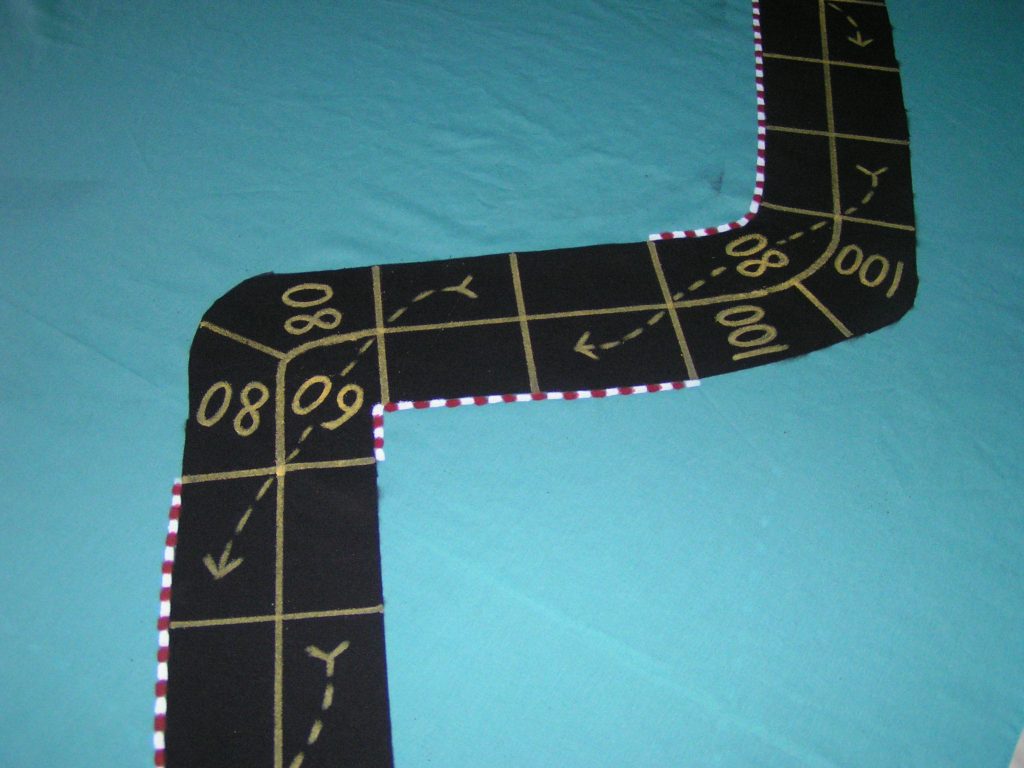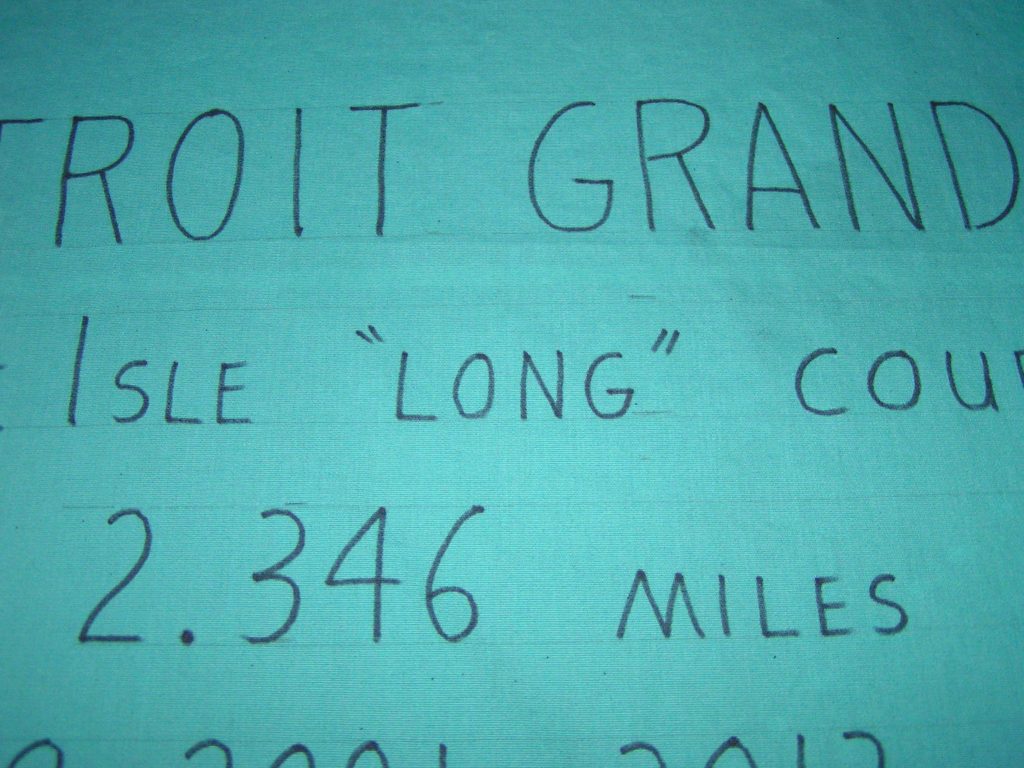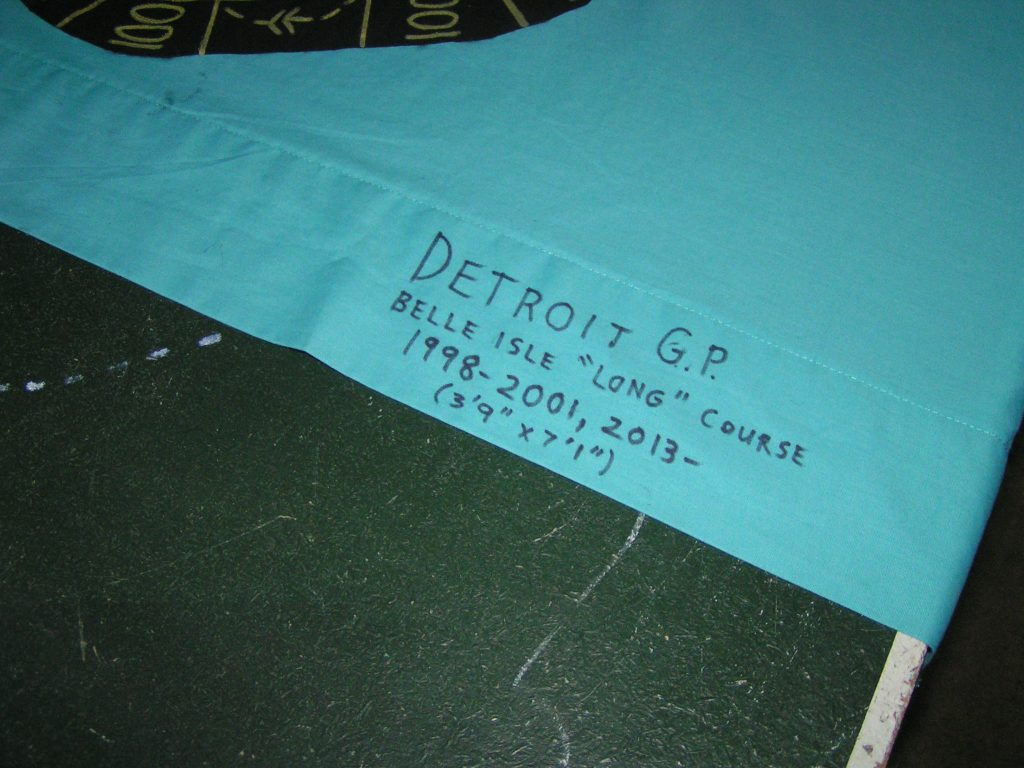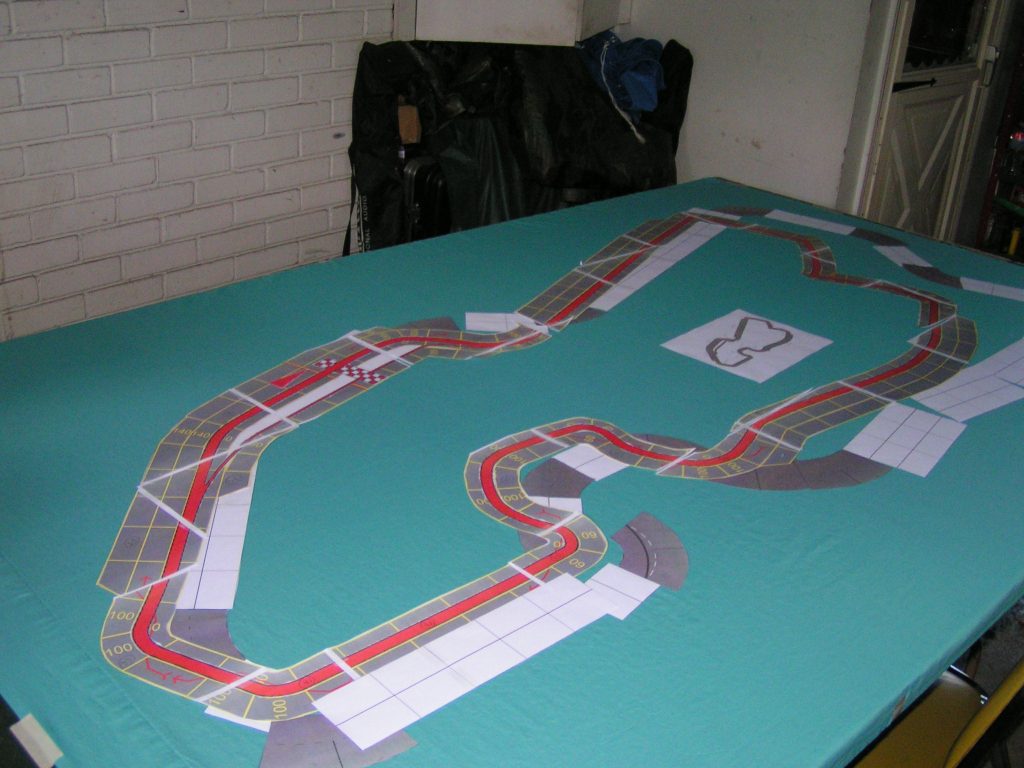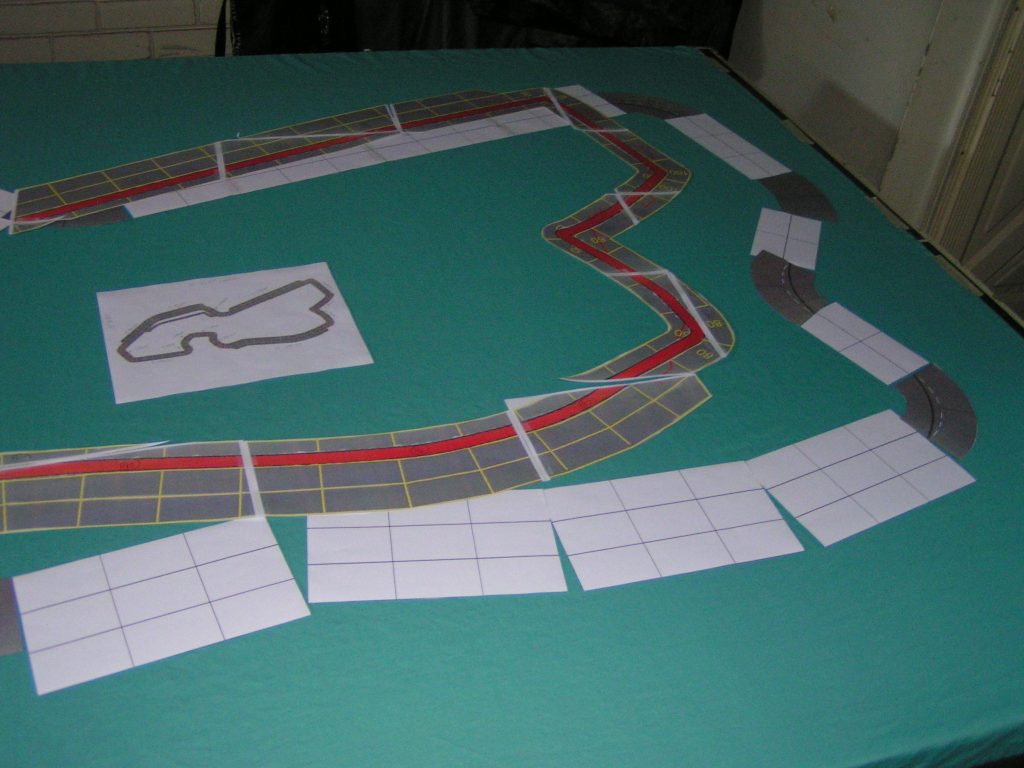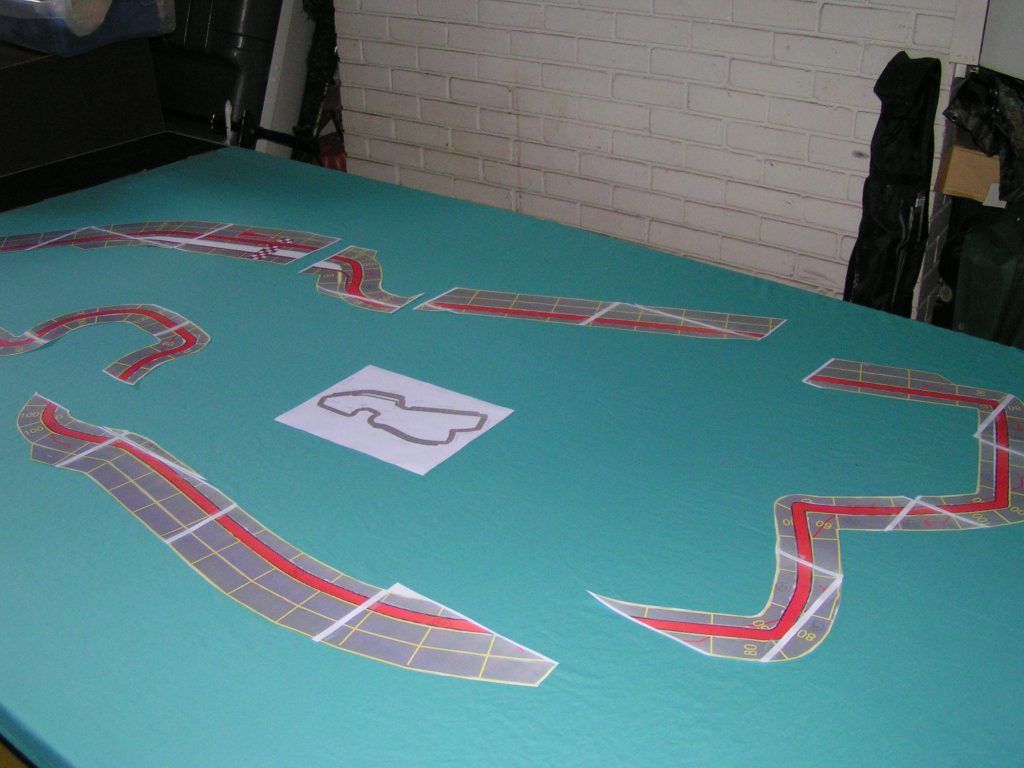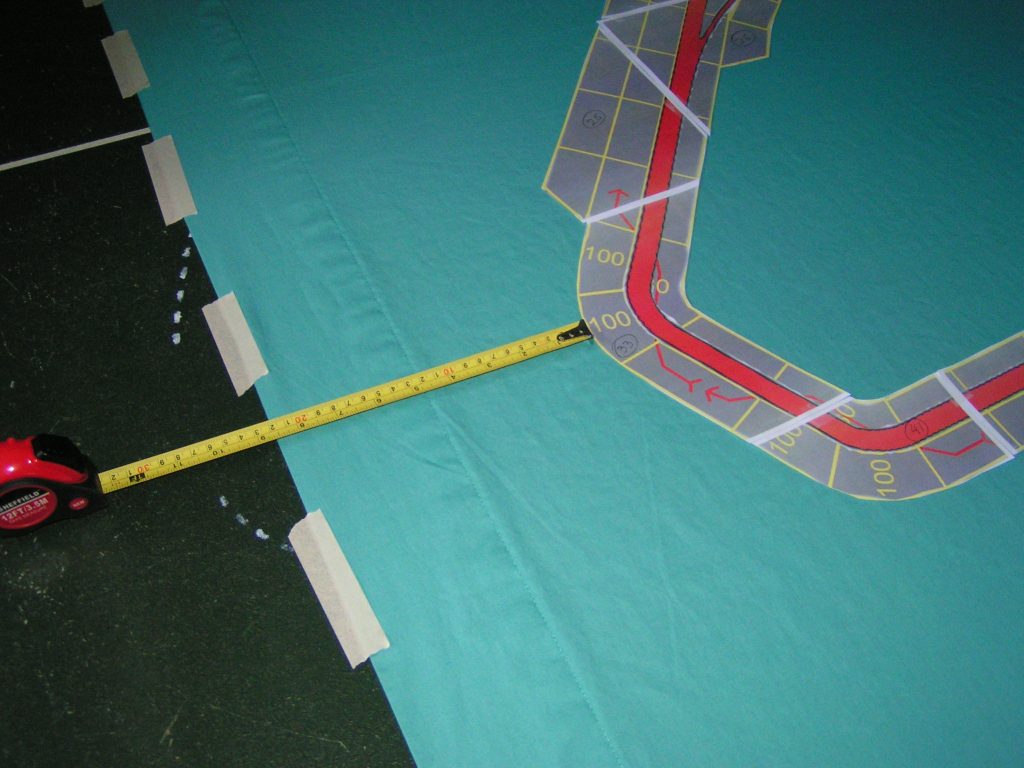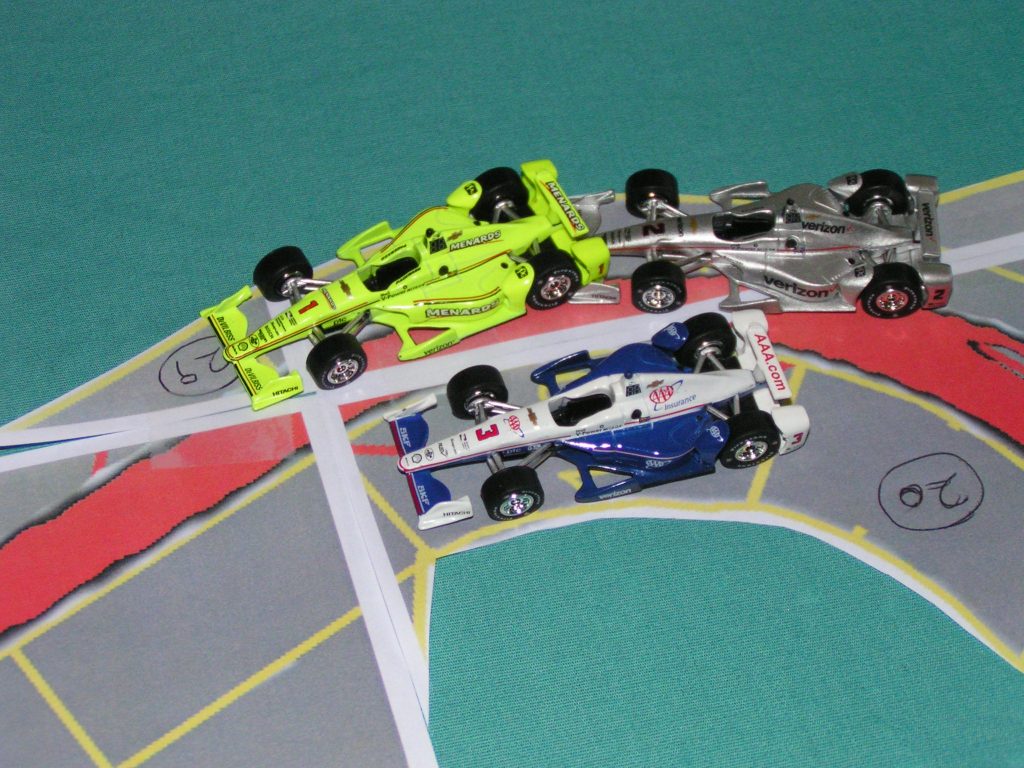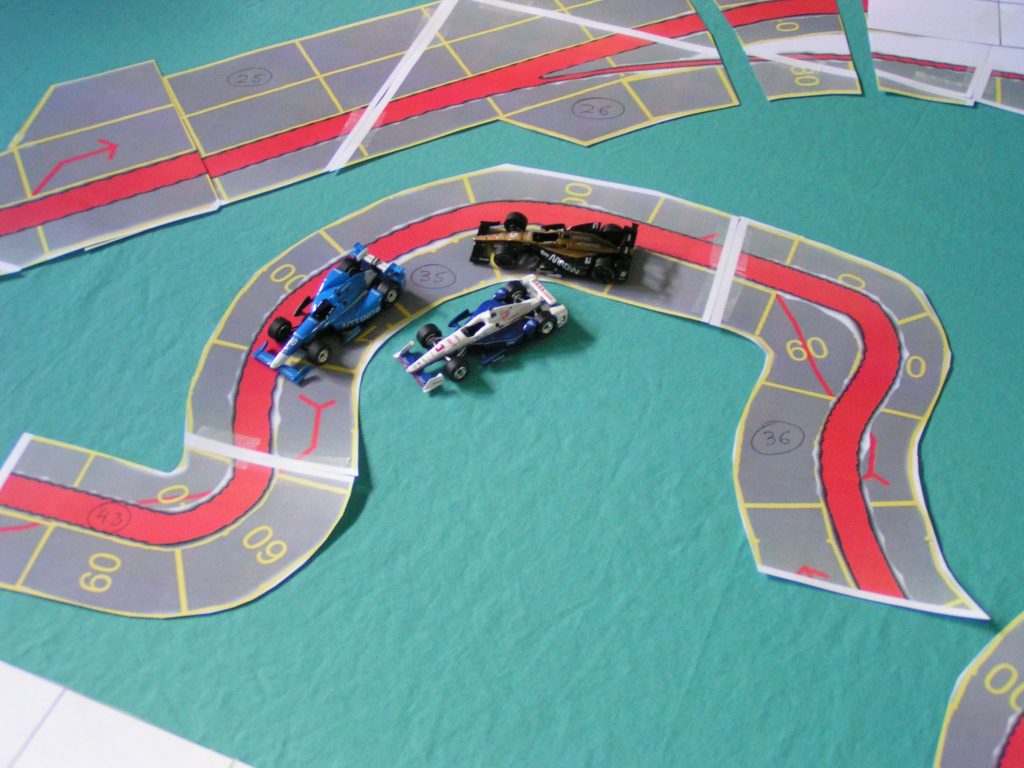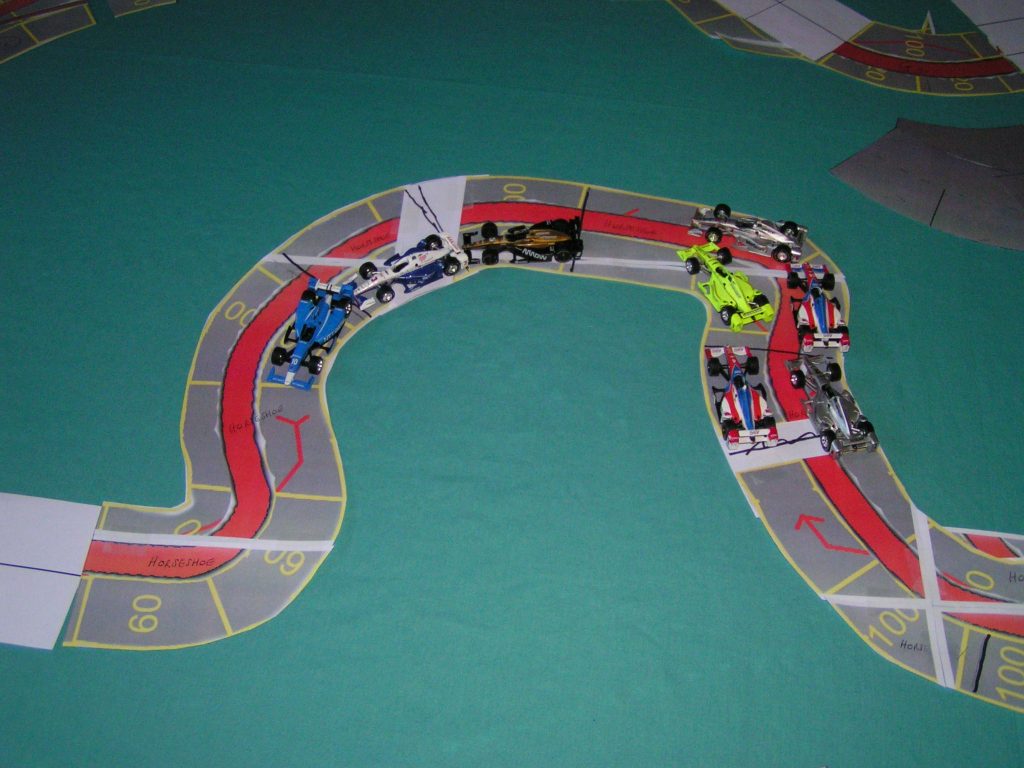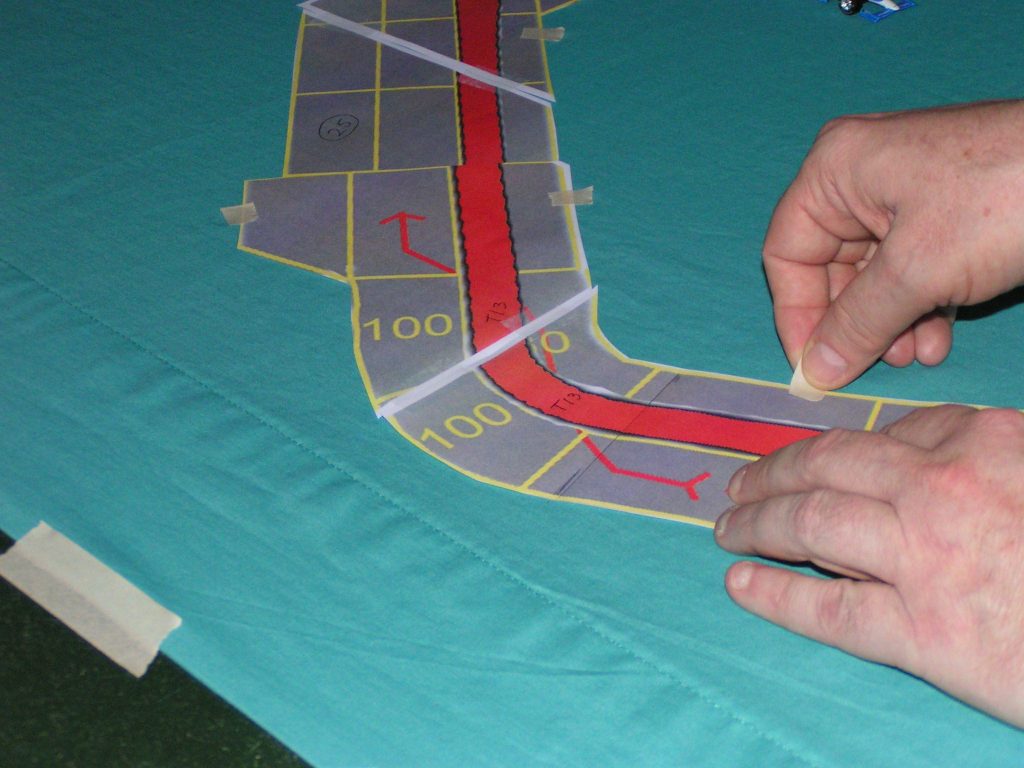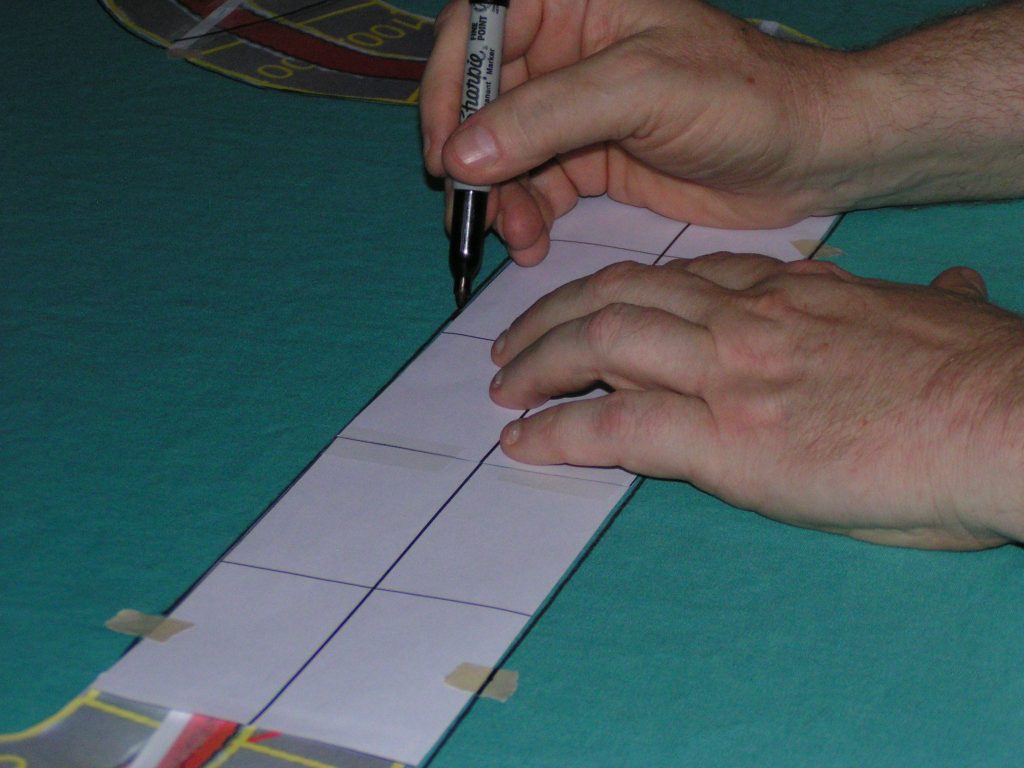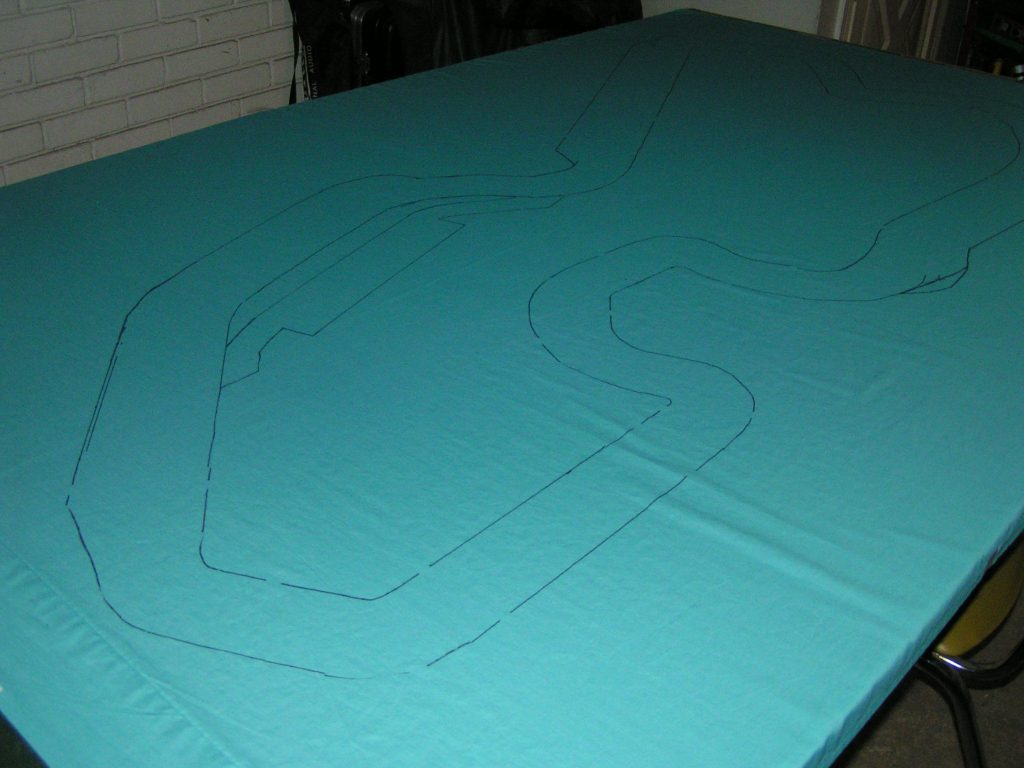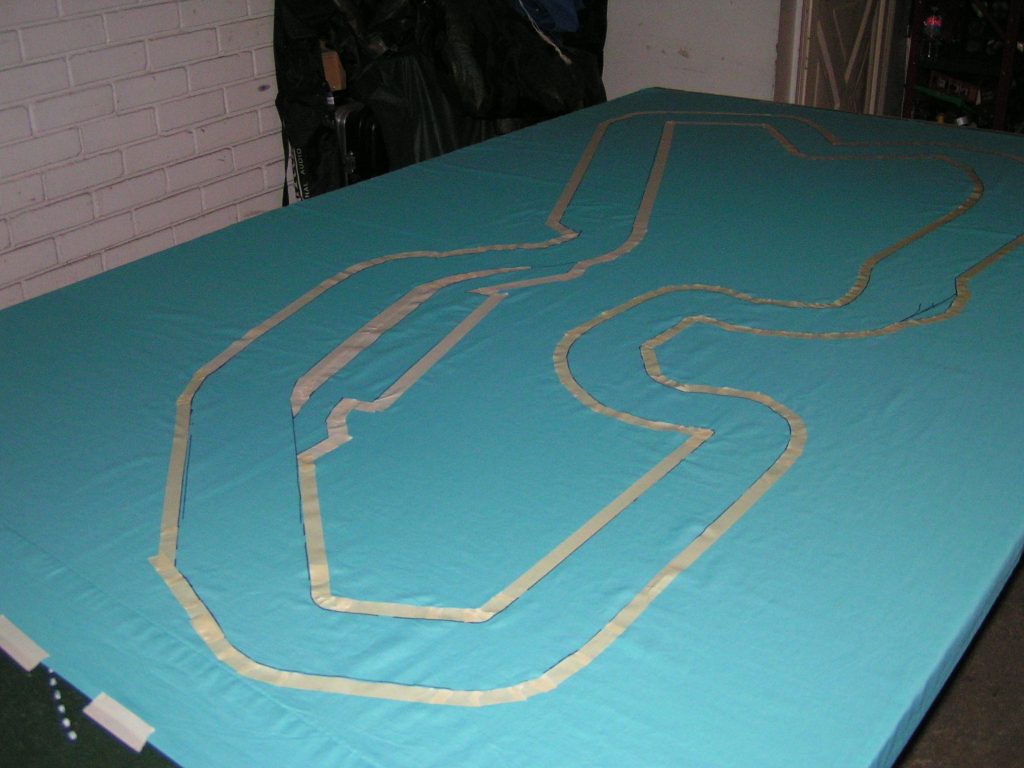The eighth and final race of the 2018 CFR-Detroit season was held at Pandemonium Games in Garden City, Michigan, on Friday, December 14, 2018. Fifteen drivers contested the race, with five of those drivers having a chance to win the points championship. When all was said and done, Bill Worrel finally drove to his first race win in CFR, and that earned him the championship over Mike Cook, Garry Kaluzny, Richard White, and Jack Beckman. Finishing 2nd at Kyalami was Richard White, and Gary Sturgeon finished on the podium in 3rd place after passing Kaluzny just before the finish line.
The race was held on the Kyalami track, from an old Avalon Hill design from Speed Circuit. This was the first time this track was used in the CFR-Detroit racing series, although it had been used in the old Advanced Speed Circuit races in the Detroit area back in the 1980s/1990s. Of course, we raced on a large-scale track that had been painted on a bedsheet so we could use our 1:64 scale cars.
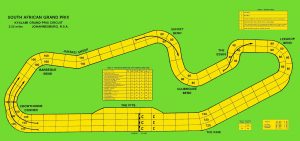
Kyalami race track of the South African Grand Prix. This was from the old Speed Circuit game and was available as an extra item from Avalon Hill.
After the drivers set up their car’s specs, the drivers secretly bid for starting positions. Each wear chit counted as 1.0, and each skill chit counted as 0.5. Higher bids started in front of lower bids. Ties were resolved by rolling percentage dice, high rolls favored over low rolls.
The four main contenders for the title, Cook, Worrel, Kaluzny, and White, all wanted to start near the front of the large pack of 15 cars. A “wild card” in this race was Louye Padol. Padol had raced in some old Advanced Speed Circuit races in the Detroit area near the end of that series in the early 1990s. Padol further stated that since he had never won a race in that old ASC series that he wanted to win a CFR race. Of course, he knew his work was cut out for him, what with the hungry drivers who really wanted to win the championship.
Qualifying
There were some high bids for pole position. Mike Cook snatched the pole with a bid of 9.5 (6 wear + 7 skill). It was Cook’s 8th pole in the 15 races he has participated in, the most of any driver. (Jim Robinson and Bill Worrel each have 2 CFR-Detroit career pole positions.) Louye Padol also started in the front row, in 2nd place, with a bid of 9.0 (8 wear + 2 skill). Garry Kaluzny started in 3rd with a bid of 8.5 (6 wear + 5 skill). Bill Worrel started 4th with his bid of 7.0 (5 wear + 4 skill). Greg Lim (3 wear + 6 skill) and Gary Sturgeon (3 wear + 6 skill) each bid 6.0. Lim started 5th after his percentile dice roll of “73” to Sturgeon’s dice roll of “06,” thus relegating Sturgeon to 6th place on the grid.
Richard White bid 5.5 (4 wear + 3 skill), so he started in the 4th row, in 7th place. Beside White, in 8th place, was Mike St. Peter with his bid of 4.5 (4 wear + 1 skill). Brian Robinson (1 wear + 5 skill) and Jack Beckman (2 wear + 3 skill) each bid 3.5 and so they had a “dice-off” for 9th and 10th place on the starting grid. Brian Robinson started 9th after rolling “63,” and Beckman started 10th after rolling “52.”
Jim Robinson was the 11th place starter with a bid of 2.5 (0 wear + 5 skill). Aric Parr (1 wear + 2 skill) and Jim Landis (1 wear + 2 skill) each bid 2.0. Parr won the dice-off by “45” to “26” and so Parr started 12th, and Landis started 13th on the grid. Joel Lauder bid only 1.0 (0 wear + 2 skill) to start 14th, and P.J. Norton (0 wear + 0 skill) bid nothing and was content to start 15th.
The starting grid for the 2018 South African Grand Prix with their car specs:
# Driver (Car) Start/Accel/Decel/Top/Wear/Skill/Tires 11 Mike Cook (Camel Lotus) 100 40 40 140 5x 3x soft 25 Louye Padol (Ligier) 100 40 40 160 5x 2x soft 8 Garry Kaluzny (Marlboro McLaren) 100 40 40 140 5x 3x soft 4 Bill Worrel (Tyrrell) 60 40 40 160 5x 3x soft 13 Greg Lim (GoDaddy) 60 60 40 160 4x 3x soft 22 Gary Sturgeon (McLaren) 100 40 40 160 5x 2x soft 1 Richard White (Brabham) 60 40 40 160 5x 3x soft 44 Mike St. Peter (Mercedes) 60 40 40 160 5x 3x hard 5 Brian Robinson (Walker Racing) 20 60 60 140 5x 3x soft 12 Jack Beckman (Ferrari) 60 40 40 160 5x 3x soft 2 Jim Robinson (Williams) 60 40 40 160 5x 3x soft 14 Aric Parr (Motul BRM) 60 40 60 160 5x 3x hard 20 Jim Landis (Benetton) 60 60 60 160 4x 2x hard 7 Joel Lauder (HSBC Jaguar) 60 60 60 180 3x 2x hard 3 P.J. Norton (Tyrrell) 60 40 40 160 5x 3x hard
Start = Start Speed (in miles/hour); Accel = Acceleration (in mph); Decel = Deceleration (in mph); Top = Top Speed (in mph); Wear = # of Wear markers (per lap); Skill = # of Skill markers (per lap); Tires = hard or soft tires to begin the race.
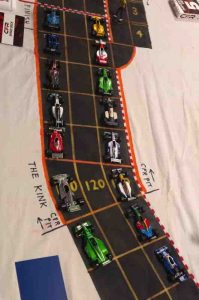
The starting grid at Kyalami: 1st row: Cook (yellow car) & Padol (blue car); 2nd row: Kaluzny (orange/white) & Worrel (blue); 3rd row: Lim (green) & Sturgeon (black/silver); 4th row: White (white/blue) & St. Peter (silver); 5th row: B. Robinson (white/blue) & Beckman (red); 6th row: J. Robinson (white/yellow/blue) & Parr (gray); 7th row: Landis (green/red/blue) & Lauder (green); 8th row: Norton (blue/white). (Bill Worrel photo)
1st Lap
At the start, pole-sitter Cook surprised the field by using his -3 skill chit and rolling dice to boost his car’s start speed to 120 mph, giving up the opportunity to use a wear (since he was on soft tires) to get the automatic 20 mph increase to his start speed. Of course, the fact Cook had bid 6 of his available 15 wear to get the pole position might have influenced his choice, since he only started the race with 9 wear. Padol and Kaluzny, both on soft tires, each used a wear to start at 120 mph. Worrel, who was starting the race with 10 wear after bidding 5 wear for qualifying, rolled dice (using two -1 skill chits) to start at 80 mph. Sturgeon was content to just start at his car’s 100 mph start speed; that allowed him to pull alongside Worrel’s blue Tyrrell. Lim used a wear to get to 80 mph; he slotted himself right behind Worrel. White, starting on the inside of the 4th row, also rolled a -2 modified start speed roll, making the roll and thus starting at 80 mph and pulling right behind Lim. St. Peter, starting on hard tires, was content to just start at 60 mph. That allowed Beckman to pull alongside St. Peter after Beckman used a wear to start at 80 mph. J. Robinson used a wear to start at 80 mph, thus leap-frogging B. Robinson who had used a wear to increase his start speed to 40 mph. Parr, starting in 12th, decided to make an unmodified start speed dice roll. Parr rolled an ‘8’ and thus started at only 40 mph, 20 mph below his car’s normal 60 mph start speed. Landis and Lauder started at their normal 60 mph start speed, and they both pulled even with Parr. Norton, making his first official start in the CFR-Detroit races, was content to start at his normal 60 mph speed.
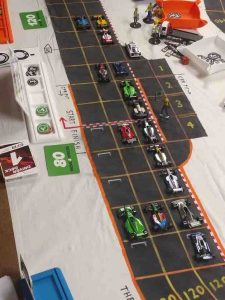
The pack roars away at the start! The order is Cook, Padol, Kaluzny, Worrel, Sturgeon, Lim, White, St. Peter, Beckman, J. Robinson, B. Robinson, Parr, Landis, Lauder, and Norton. (Bill Worrel photo)
On the 2nd move of the game, the leading trio of Cook, Padol, and Kaluzny all increased their speed to 140 mph through the Crowthorne Corner. Worrel spent a -1 skill marker and successfully rolled dice to increase his acceleration. J. Robinson rolled a -2 acceleration roll (and made it). Most of the following cars maintained their order, although Beckman got by St. Peter, and J. Robinson pulled to the inside of St. Peter. Landis got by Parr, and Lauder pulled alongside B. Robinson. As the leaders approached the Jukskei Sweep, Worrel and Sturgeon had caught up to the leading trio. Lauder moved to the inside of White.
Going into Clubhouse Bend, Kaluzny passed Padol for 2nd, and the pack was all bunched up again.
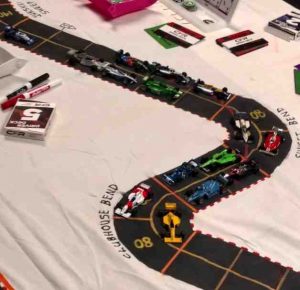
Cook still leads at Clubhouse Bend, followed by Kaluzny, Padol, Worrel, Sturgeon, Lim, White, Beckman, J. Robinson, Lauder, St. Peter, B. Robinson, Landis, Parr, and Norton. (Bill Worrel photo)
St. Peter spent two wears and two -1 skill markers (making a chance roll) going through The Esses at 120 mph. Parr tried to force a pass by Landis through Clubhouse Bend, but was balked. Parr then had to scrub off 40 mph to reduce his speed to 60 mph.
Going through Leeukop Bend, Cook was able to get clear of the pack, opening a 3-space lead over Kaluzny. Cook was one space shy of The Kink, though, and so he was unable to enter the pits before his following competitors. Then on the next move of the race, Cook did pull into the pits just after crossing the start/finish line. It was the 17th lap Cook has led in his CFR-Detroit driving career, far and away the most of any driver. (Cook has led 38% of the laps he has raced.) Also pitting were Kaluzny, Worrel, Sturgeon, White, and Padol. Lim accelerated to 160 mph out of Leeukop, but then had to roll a -2 deceleration roll to reduce his speed to 140 mph as he didn’t have any wear remaining and so would not have been able to enter The Kink at 160 mph. That left Lim one space shy of getting into the pits on that move.
During the immediately succeeding move, the cars of Lim, Beckman, and B. Robinson joined the other cars in the pits; they were eventually joined in the pits by Parr. B. Robinson made a -2 chance roll going through The Kink so he could get into the pits at a higher speed. Not pitting were Lauder, J. Robinson, St. Peter, Norton, and Landis. Lauder was then the leader on the track due to his staying out of the pits.
The official order at the end of the 1st lap: Cook (0); Lim (+3); Lauder (+11); J. Robinson (+7); St. Peter (+3); Norton (+9); Worrel (-3); Kaluzny (-5); Sturgeon (-3); White (-3); Padol (-9); Landis (+1); Beckman (-3); B. Robinson (-5); and Parr (-3). The numbers in parentheses indicate how many places a driver either gained (+) or lost (-) from their starting position. After the pit stops were resolved, the running order on the track was Lauder, J. Robinson, St. Peter, Norton, Cook, Worrel, Kaluzny, Sturgeon, White, Padol, Landis, Lim, Beckman, B. Robinson, and Parr.
2nd Lap
Coming out of the pits, Worrel made a -1 modified dice roll to boost his top speed to 180 mph. Kaluzny also used a -1 modifier to increase his top speed to 160 mph. Since the top four contenders basically needed to win the race to also win the championship, they knew going in to this race that they would need to roll some dice! Going into Sunset Bend, Cook made a -1 deceleration roll, and St. Peter used 2 wear and made a -2 chance roll. Then going through Clubhouse Bend, J. Robinson took the lead from Lauder. White then made a forced pass of Worrel coming out of Clubhouse Bend.
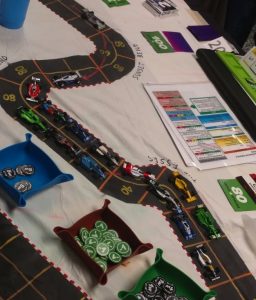
Jim Robinson takes the lead. Following are Norton, Lauder, St. Peter, Cook, Kaluzny, White, Padol, Worrel, Sturgeon, Landis, Lim, Beckman, B. Robinson, and Parr. (Bill Worrel photo)
Jim Robinson managed to gain a 2-space lead over Norton and Lauder coming out of Leeukop, but J. Robinson had to make a -3 chance roll to gain that advantage. Cook had to make a -1 deceleration roll going into Leeukop (dropping to 80 mph from 100 mph), as the road ahead was blocked by Norton’s Tyrrell. In the process, Cook used his last skill modifier, leaving him with no more skill markers, and there was still a little more than a lap left to race.
Now the dice started really flying. Jim Robinson needed to pit, and he wanted to pit on his current move, so he rolled a -2 chance at The Kink, but he spun. He had to roll as he was out of wear. Then Lauder tried to get into The Kink at 160 mph, so he used a wear and also rolled a -2 chance. Lauder also spun. Although spun, both J. Robinson and Lauder’s cars were placed into the pits, as The Kink corner was the first space where cars could pit. Norton made a -2 acceleration roll coming out of Leeukop so he could go 140 mph. That left him once space short of The Kink, meaning he couldn’t get into the pits on this move.
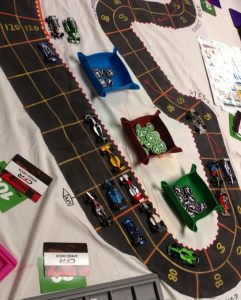
J. Robinson and Lauder both spin going into the pits (so their cars are both facing backwards to indicate they have spun). Other cars on the track are Norton, St. Peter, Cook, Kaluzny, Padol, Sturgeon, White, Worrel, Lim, Beckman, Landis, B. Robinson, and Parr. (Bill Worrel photo)
During the next move, Norton and St. Peter made it through The Kink, then they both pulled into the pits. Cook, Padol, Kaluzny, and Worrel all made it through The Kink, and Sturgeon and White were in The Kink. That meant all six of those cars could accelerate down the long straight. Cook made an unmodified top speed roll to move at 160 mph. Worrel made an unmodified top speed roll to move at 180 mph. Kaluzny wanted to move at 160 mph, and had to roll for his top speed. In spite of using a -1 skill modifier, Kaluzny failed the roll. He moved this turn at 140 mph, and his future top speed was now only 120 mph. So he knew his shot at the championship was doomed. Landis pulled his car into the pits, as he was the last of the cars that had not yet pitted.
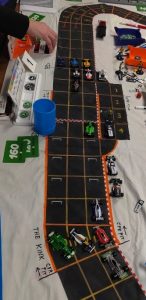
Cook, Padol, and Worrel vie for the lead to begin the 3rd lap. (Their cars are near the Monty Python-esq hand of Kaluzny.) Kaluzny and White are right behind the leaders, and Sturgeon is also right behind. Lim is just crossing the start/finish line. B. Robinson is just in front of Beckman who is just in front of Parr. The cars of J. Robinson and Lauder have come out of the pits to be placed back in the track in The Kink, but are facing backwards to show they have spun. In the pits are Norton, St. Peter, and Landis. (Bill Worrel photo)
P.J. Norton (+14) was the official leader of the 2nd lap, although he was in the pits when he achieved that honor. The rest of the official order for the 2nd lap: Cook (-1); Padol (-1); Worrel (0); Kaluzny (-2); White (+1); Sturgeon (-1); Lim (-3); B. Robinson (0); Beckman (0); Parr (+1); St. Peter (-4); Lauder (+1); J. Robinson (-3); and Landis (-2).
3rd Lap
Worrel made a daring move to take the lead going into Crowthorne Corner at the end of the long straight. Since he was on the outside of the track, and would have moved after other cars that plotted the same speed, Worrel plotted 180 mph, made his top speed dice roll, but then slowed to 160 mph before actually entering the corner. That let Worrel move before Cook and Padol. Cook did move alongside Worrel in Crowthorne, with Padol right behind them in 3rd. Kaluzny and White were side-by-side behind Padol, and Sturgeon was behind White.
Worrel and Cook were side-by-side racing through Barbeque Bend and the Jukskei Sweep. Kaluzny, with his damaged top speed, moved to the outside in Barbeque Bend, letting White pass on the inside. Kaluzny did not want to hold up a competitor who had a chance for the championship.
Then came the stunning event of the race. Cook made an unmodified top speed roll to move at 160 mph (so he could move before Worrel) headed into Sunset Bend, and then Cook made an unmodified deceleration roll to get down to 140 mph for the corner. Cook then used 2 wear and rolled an unmodified chance (Cook was on hard tires and so couldn’t use 3 wear, and he was out of skill markers). Unfortunately for Cook, he crashed and was suddenly out of the race, just when he was going for the lead! (Note that if Cook had made the roll successfully, it would have been a piece of “brilliant driving” and might have won the game for him.) Worrel’s car pulled up just short of Sunset, and he took the inside lane, eschewing the cornering arrow that was in the outside lane. Padol then pulled alongside Worrel and took the arrow. White pulled ahead of Kaluzny, and Sturgeon pulled alongside Kaluzny.
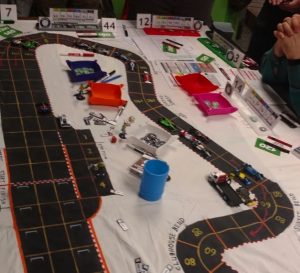
Cook has crashed in Sunset Bend (upside down yellow car next to the flat-bed truck). Worrel and Padol are side-by-side just before Sunset Bend, followed by White, Kaluzny, Sturgeon, Lim, Beckman, B. Robinson, Norton, Parr, St. Peter, Lauder, J. Robinson, and Landis. (Bill Worrel photo)
Now Worrel and Padol had a spirited battle on the track. Worrel spent 3 wear through Sunset and Clubhouse, leaving him with only 3 wear remaining for the rest of the race (and with three more corners to go). Worrel then pulled ahead of Padol at The Esses, as Worrel used a wear and made an unmodified chance roll. (It goes without saying that White, Padol, and Kaluzny were hoping for a spin or crash!) As Padol had taken the line behind Worrel, White had to go off-line at The Esses, using 2 wear and making a -2 chance roll so he could be at 100 mph.

Worrel moves in front at The Esses. Padol and White are right behind, then are Kaluzny, Sturgeon, Lim, Beckman, B. Robinson, Norton, St. Peter, Lauder, Parr, J. Robinson, and Landis. Cook’s crashed Camel Lotus has been loaded on the flat-bed truck, and the flagman is waving the yellow caution flag just before Sunset Bend. (Bill Worrel photo)
Worrel then pretty much wrapped up the race victory and the championship at Leeukop, as he was the only car that made it to the end of the corner where he would be able to accelerate out of that corner in the next move.
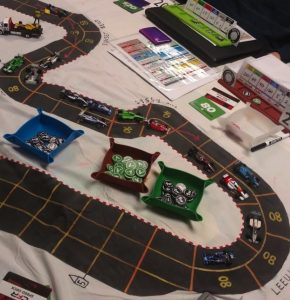
Worrel continues to lead at the exit of Leeukop. White is 2nd, Kaluzny has taken the inside and 3rd place from Padol (who is 4th). Sturgeon is 5th, and Beckman (red Ferrari) has just passed Lim for 6th place in The Esses. (Bill Worrel photo)
From that point on, the race to the finish line was an anti-climax, as Worrel crossed the line 3 spaces ahead of White and Kaluzny to win the race and the 2018 CFR-Detroit championship! Kaluzny had used a slip to pull alongside White, especially as Kaluzny didn’t dare roll for his top speed again.
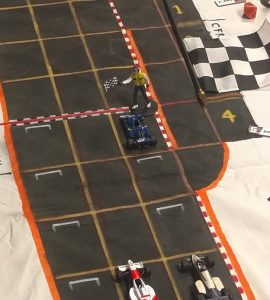
Worrel takes the checkered flag to win the 2018 South African Grand Prix and also winning the 2018 CFR-Detroit points championship. (Bill Worrel photo)
There was still a race on for other positions. Beckman made a -3 chance roll at Leeukop, and Brian Robinson used 2 wear and made a -3 chance roll, also at Leeukop. At some point late in the 3rd lap, Padol failed a top speed or acceleration roll, although it wasn’t recorded when it happened. Failing that roll cost Padol a couple of positions at the finish, at least. Also, Sturgeon was able to pass Kaluzny as they crossed the finish line, thereby earning a podium finish in 3rd for Sturgeon.
The official finishing order at the 2018 South African Grand Prix: 1st-Bill Worrel (+3); 2nd-Richard White (+5); 3rd-Gary Sturgeon (+3); 4th-Garry Kaluzny (-1); 5th-Louye Padol (-3); 6th-Jack Beckman (+4); 7th-Greg Lim (-2); 8th-P.J. Norton (+7); 9th-Brian Robinson (0); 10th-Mike St. Peter (-2); 11th-Joel Lauder (+3); 12th-Jim Robinson (-1); 13th-Aric Parr (-1); 14th-Jim Landis (-1). Classified in 15th with a DNF was Mike Cook (-14).
Aftermath
Louye Padol had a nice drive for his first race using the CFR rules. He was in contention, but he seemed to not want to interfere with the four-way battle for the lead amongst the main contenders for the title. And P.J. Norton, although he had previously raced in a few demo races, performed well in his first official CFR race, moving up 7 places from his starting position to finish in 8th place.
Points awarded at the 2018 South African Grand Prix: Worrel 10; White 6; Sturgeon 4; Kaluzny 3; Padol 2; Beckman 1.
The final points standings of the 2018 CFR-Detroit season (after eight of eight races):
Place Driver (Car) Points 1 Bill Worrel (Tyrrell) 37* 2 Richard White (Brabham) 32 3 Garry Kaluzny (Marlboro McLaren) 30 4 Mike Cook (Camel Lotus) 29 5 Jack Beckman (Ferrari) 20 6 Jim Robinson (Williams) 18 7 Gary Sturgeon (McLaren) 14 8 Mike St. Peter (Mercedes) 9 9T Brian Robinson (Walker Racing) 4 9T Aric Parr (Motul BRM) 4 9T Jim Landis (Benetton) 4 12T Joel Lauder (HSBC Jaguar) 2 12T Greg Lim (GoDaddy) 2 12T Louye Padol (Ligier) 2 15T Mark Moellering (McLaren) 0 15T Gary Kempen (Williams) 0 15T Chuck Modzinski (Arrows) 0 15T Jim Lauder (Shadow) 0 15T P.J. Norton (Tyrrell) 0
* Drivers could only count their 6 best finishes out of the 8 races. Bill Worrel had to forfeit 1 point (from a 6th place at Monaco) due to his having earned points in 7 races. (Worrel did earn 38 points, but could only count 37 of them.)
After the race, Bill Worrel was awarded the 2018 CFR-Detroit Individual Points Championship trophy from outgoing race steward Garry Kaluzny. Kaluzny was then surprised when the rest of the drivers gave Kaluzny a trophy for the appreciation the drivers had for his organizing and running the race series for 2017 and 2018.
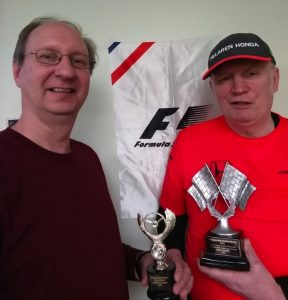
Bill Worrel with his 2018 CFR-Detroit championship trophy (left), and Garry Kaluzny with his appreciation trophy (right).
After the championship trophy presentation, the drivers continued to uphold an old tradition dating back to the Advanced Speed Circuit days in Detroit–they voted to award the “Tom Kane Memorial Award” to the most sportsmanlike driver of 2018. Each driver got to vote for one driver, via secret ballot. The voting tallies were:
Jim Landis – 7
Jim Robinson – 3
Jack Beckman – 2
Greg Lim – 2
Thus, Jim Landis was voted the Most Sportsmanlike driver of 2018 and was awarded the Tom Kane Memorial Award trophy.
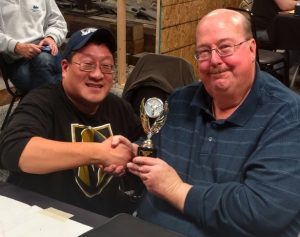
Jim Landis (right) receives the Tom Kane Memorial Award trophy as the CFR-Detroit Most Sportsmanlike driver of 2018. Presenting the award is the 2017 Most Sportsmanlike driver, Greg Lim (left). (Bill Worrel photo)
In the 2018 CFR-Detroit racing season, a total of 20 different drivers took part in the eight races. The most drivers at any race was 15, at both the Belgian and South African Grand Prix. The fewest drivers in any race was 11, at both the Italian and German Grand Prix. The average number of drivers for the season was 12.8 drivers per race. This was an increase from the average of 10.3 drivers per race in 2017.
For the 2019 CFR-Detroit racing season, Jack Beckman will be the race steward. There will also be a “team championship” award added, and already the drivers have mostly formed teams for 2019.
As always, keep up to date for the CFR-Detroit schedule at the CFR-Detroit home page at http://michigumbo.com/cfr/.
A demo race will take place at Flintcon (in Flint, Michigan) on Saturday, February 9, 2019, using the Indianapolis road course. The actual 2019 CFR-Detroit schedule begins on Friday, February 15, 2019, at Pandemonium Games in Garden City, Michigan. We will race the Australian Grand Prix using the Adelaide track. Qualifying begins at 6:45pm. No experience is necessary; you are welcome to join us!
